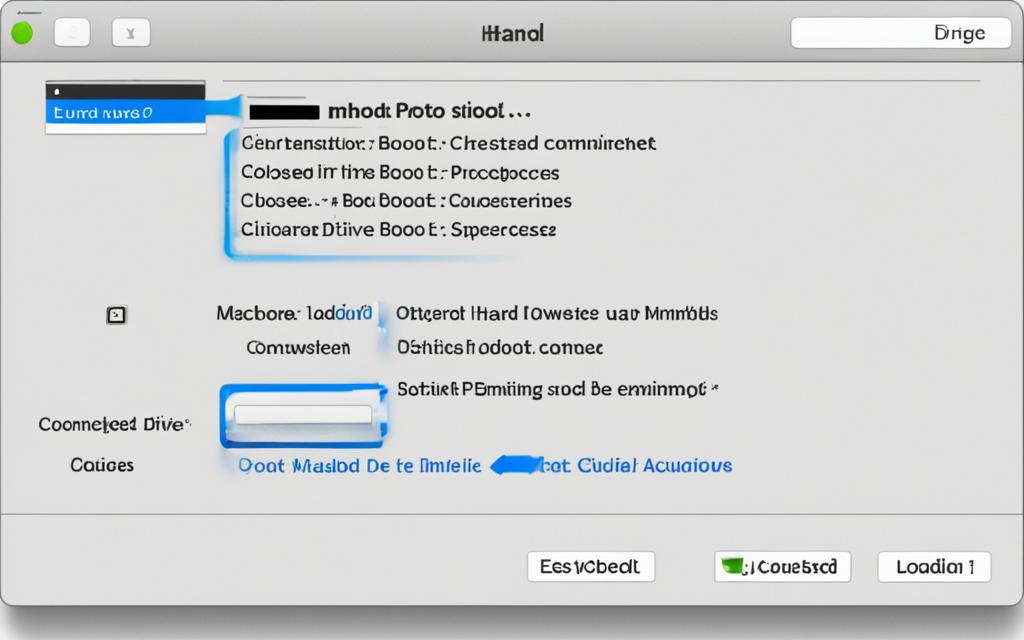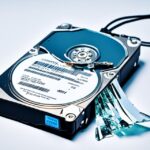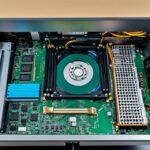Table of Contents
Booting from an external hard drive on a Mac offers many benefits. It gives users flexibility and control over their computing needs. You can use it for data recovery, system maintenance, or trying new macOS versions. A bootable external drive can improve your experience.
This approach is great for those needing a backup or wanting to protect their main system. Apple supports various storage solutions, so knowing how to set up an external drive is key1. We will look at how to prepare an external hard drive for a Mac.
Key Takeaways
- Booting from an external hard drive enhances flexibility and portability.
- Data recovery and system maintenance are easily managed with an external boot drive.
- Proper formatting of the external hard drive is vital for a successful macOS installation.
- Understanding individual Mac models’ port requirements can simplify the process.
- Using the correct startup procedure is essential for accessing the external drive.
- Software updates are critical when running macOS from an external drive.
Understanding the Benefits of Booting from an External Hard Drive
Booting from an external drive brings many perks. These include flexibility and being able to move around easily. It lets users take their operating system and files to different Macs. Carrying crucial data does not only depend on the internal drive. This is handy for pros or tech lovers. External drives are great for backups, especially if the internal one fails. They also help a lot with data recovery Mac issues.
Enhanced Flexibility and Portability
Using an external SSD as a start-up disk makes Macs more adaptable. This works for models like the iMac (Late 2012 to 2019) and Mac mini (Late 2012 and Late 2014)2. With USB 3.1, an SSD can hold lots of files, such as music and videos. It’s a flexible storage choice. The LaCie Mobile SSD Secure USB-C Drive is one good option for booting.
Data Recovery and System Maintenance
External drives are key for system maintenance external hard drive, especially with system crashes. If a 2019 iMac is slow to start or log in, moving data to an SSD can speed things up3. The latest macOS versions, like Sonoma and Ventura, support different external drives well. The Migration Assistant makes it easy to move files and settings to a new SSD.
Apple’s choice to solder SSDs into machines makes external drives a cheaper option for upgrades4. They offer a smart solution when you can’t replace internal parts. For those wanting good performance without overburdening their Macs, external SSDs are perfect. They ensure a smooth computer use every day.
Preparing Your External Hard Drive for Booting
To get your external hard drive ready for booting on a Mac, first, choose the right drive. It must meet specific requirements for it to work well. For instance, picking a drive with a minimum of 64GB storage is key. That way, there’s enough room for your operating system and extra files. Solid-state drives (SSDs) are quicker, offering fast access speeds. On the other hand, traditional hard drives (HDDs) give you more space for your data. Knowing the differences helps you make a better choice for your Mac.
Choosing the Right External Hard Drive
Think about what you need in terms of speed and space when selecting an external drive for your Mac. SSDs can make your Mac boot faster but are pricier. If you need more storage at a lower cost, HDDs are the way to go. Make sure the drive you choose works well with macOS to prevent formatting troubles. Many drives are set up for Windows right out of the box. You’ll likely need to reformat it for macOS. This step is crucial for the drive to work well with your system.
Formatting Your Drive Correctly
After picking the right external drive, you must format it properly. This is especially important if it isn’t compatible right away5. For those using macOS High Sierra or newer, APFS is the suggested file system6. It’s designed to boost both performance and security. You can use the Disk Utility app for this process. It lets you clear out any files you don’t need. Doing so prepares your external drive for booting. It ensures everything runs smoothly when you start macOS from it.
How to Boot from an External Hard Drive on a Mac
To boot from an external hard drive on a Mac, first ensure it’s effectively connected. Mac models have specific ports for connecting. Check which port is best for your Mac. Making sure your hard drive connects well is key, especially with recent macOS updates. This is since macOS Catalina7 made bootable backups more challenging.
Connecting to the Appropriate Port
For a successful boot, connect the hard drive to the right port. Some USB-C ports on Macs might not work for booting. It’s important to check your Mac’s specs first. A good connection means a better chance of a smooth boot.
Verifying the Drive Format
The next step is making sure the drive is compatible. It must be formatted in APFS or Mac OS Extended (Journaled) for booting. Use Disk Utility to check the external drive format. It’s crucial, as newer macOS versions have tighter security. These might limit booting externally without changes7.
Time Machine might have a bootable section, but it’s not fully bootable on its own. For creating a bootable drive, check out this guide on making a bootable external hard drive for Mac here.
Installing macOS on Your External Hard Drive
Starting to install macOS on your external drive needs a few key steps. This makes sure your setup goes smoothly and improves your Mac’s use. Use this guide to make installing macOS easy and effective.
Downloading macOS from the App Store
First, download macOS from the App Store. Do this in three easy steps: open the App Store, find the macOS you need, and click download. Remember, macOS Ventura beta files could be about 12GB, so check you have enough space on your drive for a successful install8.
Step-by-Step Installation Process
Then, start the install process. Here are the steps for the external drive:
- Connect your external drive to your Mac.
- Open the ‘Disk Utility’ app to format the drive if you haven’t done so already.
- Run the installer you downloaded from the App Store.
- Select your external drive as the destination for macOS and start the install, which might take a bit longer than expected8.
Completing the Installation
After installing, it’s vital to check it worked. Restart your Mac and press the Option key. You should see the external drive as a boot option. If your Mac boots up from the external drive, then the macOS install was a success9.
In the end, installing macOS on an external drive offers a great mix of portability and better performance. It gives your Mac a new lease of life.
Selecting Your Startup Disk
After you install macOS on an external hard drive, you should make it the default boot disk. This boosts your Mac’s performance. Just head into System Preferences to adjust your startup disk settings.
Accessing System Preferences
Start by clicking the Apple logo at the top left of your screen. Choose System Preferences from the menu that appears. Then, in the System Preferences window, find and click the Startup Disk icon. Here, you’ll see all the startup disks you can choose from, including your external drive.
Starting Up from Your External Drive
To boot from your external drive, go to the Startup Disk settings and pick it. If it’s not showing up, check if the drive is properly connected and on. Make sure it has an operating system installed. Once selected, hit Restart to boot from it. Keep in mind, the steps vary slightly for Macs with Apple silicon and those with Intel chips. Be sure to follow the right instructions for your Mac. While some users always start up from macOS, changing the startup disk is useful for multi-boot setups or for testing1011.
Knowing how to do this is key to unlocking your Mac’s full power. It’s especially useful when you’re working with external storage11.
Using System Preferences Mac is vital for easily booting from an external startup disk.
For extra tips on getting the most out of your Mac, be sure to read the in-depth guide here.
Conclusion
Booting from an external hard drive on a Mac brings lots of flexibility and portability, making your computing better. By following simple steps, you can get your external drive ready. This lets you do things like fixing your system or trying new software. You can also easily share data across different devices and keep a safe backup of important files.++p>
External boot options offer great advantages. They make it easier for you to use macOS in different ways. Also, tools like AOMEI Partition Assistant let you run Windows on your Mac without issues. With the right plan and tools, moving to an external hard drive becomes easy. This changes the way you use your devices for the better.
Knowing how to boot from an external hard drive can really change how you manage your digital life. It’s very important to pick the right drives and to follow good steps. This helps make sure everything works great. Following these tips can help you get the most out of your Mac. You’ll be ready for anything that comes your way121314.
FAQ
What are the advantages of booting from an external hard drive on a Mac?
Booting from an external hard drive on a Mac brings lots of flexibility. You can easily take your operating system and files anywhere. It’s great for recovering data and as a secure backup when fixing your Mac. You can also try out new macOS versions without touching your main system.
How do I choose the right external hard drive for booting?
Choose an external hard drive that’s at least 64GB and works with macOS. If you want fast speeds, pick a solid-state drive (SSD). For more space, a traditional hard drive is good. Make sure it’s formatted correctly for booting.
What format should my external hard drive be in to boot from it?
Your external hard drive needs to be in APFS format for newer macOS versions. Use Disk Utility to format it right. This makes it ready for booting and clears out old data.
How can I verify that my external hard drive is formatted correctly?
Check your drive’s format in Disk Utility. Only drives in APFS or Mac OS Extended (Journaled) work for booting. It’s important to confirm this before you install anything.
What is the process to install macOS on my external hard drive?
To get macOS on your external drive, download it from the App Store or use macOS Recovery. Choose the external drive as where you want to install during the process. Then, just follow the installer instructions.
How can I select my external hard drive as the startup disk?
Set your external drive as the startup disk in System Preferences. Go to Startup Disk settings and pick your external drive. Restart your Mac to boot from the external drive after this.
Can I use my external hard drive for both booting and storing files?
Yes, your external hard drive can double as a bootable macOS drive and storage. Just make sure it has enough space for both your files and the operating system.
How can booting from an external hard drive help with data recovery?
Booting from an external drive is key for getting back lost or hard-to-reach files. It’s a solid backup choice, helping you access crucial data when your system is down.
Source Links
- https://support.apple.com/en-us/111336 – Use an external storage device as a Mac startup disk – Apple Support
- https://discussions.apple.com/docs/DOC-250003583 – Use an external SSD as your startup disk …
- https://discussions.apple.com/thread/251464557 – Boot iMac from external SSD, what happens…
- https://eshop.macsales.com/blog/55907-using-an-external-drive-as-your-startup-drive-part-1/ – Using an External Drive as Your Startup Drive: Part 1
- https://www.wikihow.com/Boot-from-an-External-Hard-Drive – How to Boot from an External Hard Drive (with Pictures) – wikiHow
- https://appleinsider.com/inside/macos-ventura/tips/how-to-make-an-external-bootable-working-drive-in-macos-ventura – How to make an external bootable working drive in macOS Ventura | AppleInsider
- https://discussions.apple.com/thread/253964158 – Booting from external hard drive
- https://www.macworld.com/article/672585/how-to-install-macos-on-an-external-drive.html – How to install macOS on an external drive
- https://www.easeus.com/computer-instruction/install-macos-on-external-drive.html – How to Install macOS on External Drive [macOS Ventura/Monterey]
- https://www.ninjastik.com/support/how-to-choose-a-startup-disk-on-your-mac-to-boot-from-usb/ – How to choose a startup disk on your Mac to boot from USB – NinjaStik
- https://www.idownloadblog.com/2015/08/24/how-to-use-mac-startup-manager/ – How to pick a startup disk for your Mac at boot time
- https://www.diskpart.com/articles/boot-windows-on-mac-from-external-hard-drive-1984.html – How to Boot Windows on Your Mac from External Hard Drive
- https://discussions.apple.com/thread/254388684 – Can I boot to an external drive that was …
- https://www.magoshare.com/mac-backup-clone/mac-boot-from-external-hard-drive.html – Move macOS to An External Hard Drive and Set It As the Boot Drive for A Mac












